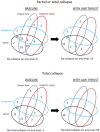Short-term positive effects of a mandibular advancement device in a selected phenotype of patients with moderate obstructive sleep apnea: a prospective study
- PMID: 35962942
- PMCID: PMC9806777
- DOI: 10.5664/jcsm.10232
Short-term positive effects of a mandibular advancement device in a selected phenotype of patients with moderate obstructive sleep apnea: a prospective study
Abstract
Study objectives: To evaluate (determinants of) treatment success of mandibular advancement device application in a selected phenotype of patients with obstructive sleep apnea (OSA).
Methods: Ninety nonobese patients with moderate OSA (obstructive apnea-hypopnea index [OAHI] ≥ 15 and < 30 events/h) without comorbidities were prospectively included. Polysomnography was performed at baseline and with a mandibular advancement device. A drug-induced sleep endoscopy with jaw thrust was performed in 83%.
Results: OAHI reduction ≥ 50% was observed in 73%, OAHI reduction ≥ 50% with OAHI < 10 events/h in 70%, and complete OSA resolution (OAHI < 5 events/h) in 40%. Patients with nonpositional OSA showed a significantly higher rate of complete OSA resolution: Posttest probability increased to 67%. In patients with total disappearance of collapse at velum level and at all levels during drug-induced sleep endoscopy with jaw thrust, the drop in OAHI was impressive with an infinitively high positive likelihood ratio. However, the proportion of patients having nonpositional OSA or the drug-induced sleep endoscopy characteristics as described above was < 20%. The change in snoring disturbance based on a visual analog scale was 76% (interquartile range 40-89%, P < .001) and a statistically significant amelioration in Epworth Sleepiness Scale (especially in somnolent subjects) was observed. High adherence was reported.
Conclusions: In this predefined OSA phenotype, a mandibular advancement device was effective in reduction of OAHI and in amelioration of symptoms. Stratification by nonpositional OSA and findings on drug-induced sleep endoscopy with jaw thrust increased treatment success defined as reduction in OAHI. However, the clinical relevance can be questioned because only a small number of patients demonstrated these characteristics.
Citation: Buyse B, Nguyen PAH, Leemans J, et al. Short-term positive effects of a mandibular advancement device in a selected phenotype of patients with moderate obstructive sleep apnea: a prospective study. J Clin Sleep Med. 2023;19(1):5-16.
Keywords: daytime sleepiness; drug-induced sleep endoscopy; mandibular advancement; obstructive sleep apnea; personalized medicine; polysomnography; snoring; supine position.
© 2023 American Academy of Sleep Medicine.
Conflict of interest statement
All authors have seen and approved the manuscript. Work for this study was performed at the University Hospital Gasthuisberg, Leuven, Belgium. All authors report they have not received financial support related to the study and all report no conflicts of interest.
Figures




References
-
- Johal A , Battagel JM , Kotecha BT . Sleep nasendoscopy: a diagnostic tool for predicting treatment success with mandibular advancement splints in obstructive sleep apnoea . Eur J Orthod. 2005. ; 27 ( 6 ): 607 – 614 . - PubMed
-
- Johal A , Hector MP , Battagel JM , Kotecha BT . Impact of sleep nasendoscopy on the outcome of mandibular advancement splint therapy in subjects with sleep-related breathing disorders . J Laryngol Otol. 2007. ; 121 ( 7 ): 668 – 675 . - PubMed
-
- Vroegop AVMT , Vanderveken OM , Dieltjens M , et al. . Sleep endoscopy with simulation bite for prediction of oral appliance treatment outcome . J Sleep Res. 2013. ; 22 ( 3 ): 348 – 355 . - PubMed
MeSH terms
LinkOut - more resources
Full Text Sources

